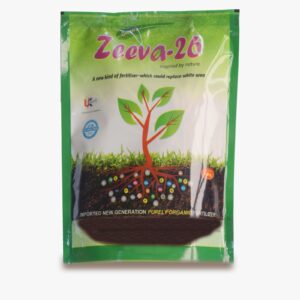Description
Calcium, Magnesium and Sulphar are known secondary nutrients. Each is having definite roll to play. It is best of soil conditioner. Green’s CMS play a vital role in supplying the above mentioned nutrients to the plant.
The secondary nutrients like sulfur (S), magnesium (Mg) and calcium (Ca), do not always get the recognition of some others, but they are essential and play key roles in the growth and health of plants, animals, and humans. They have been called the “synthesizers” because of their functions in living organisms.
Many factors can affect the availability of these three nutrients to plants. The best estimates of their availability can be determined by soil analysis or a combination of soil and plant analyses. However, field observations and deficiency symptoms are also important diagnostic tools.
Calcium plays an important role in lengthening the roots and shoots and there by improving the growth and development in plants Calcium requirement of yielding plant is quite high and it is more during the flower setting and seed ripening. 90% of calcium uptake is during flowering and pod formation stages.
An important aspect of calcium nutrition in Coffee and Tea is that the calcium taken up by the plant from soil will remain in the leaf tissues, and will not move from the leaves to the developing pods where its requirement is high. For this reason calcium should be sufficiently available in the podding zone at peg formation stage to pod maturity. To get good yields of quality Crop, adequate amount of calcium should be present in the soil from early flowering of the crop onwards.
- Calcium as calcium pectate is an important constituent of cell wall and required for cell division. It is a structural component of chromosomes. It includes stiffness to straw and there by tends to prevent lodging. It enhances the nodule formation in legumes, helps in translocation of sugars, neutralizes organic acids which may become poisonous to plants. It is an essential co-factor or an activator of number of enzymes. It improves the intake of other plant nutrients, specially nitrogen and trace elements by correcting soil pH. Excessive amounts of calcium can decrease the availability of many micronutrients.
- Deficiency of calcium lead to ‘Die back’ at the tips and margins of young leaves. Normal growth of plants is arrested i.e., roots may become short, stubby and bushy, leaves become wrinkled and the young leaves of cereal crops remain folded. The acidity of cell sap increases abnormally and it hampers the physiological function of plant. As a result of which plant suffers and causes the death of plant at last.
- When urea (46-0-0), anhydrous ammonia (82.5-0-0) or di ammonium phosphate(DAP) (18-36-0) is banded into the soil, an equivalent amount of calcium is precipitated. The plant roots cannot access nitrogen in an environment containing more than 32 percent ammonium. Roots can be killed, but usually they grow around the fertilizer bands. After the soil microbes have converted much of the banded ammonium to nitrate, then the roots can begin to use the nitrogen. When extra soluble calcium is applied with the fertilizer it lowers the pH of the fertilizer band, thus reducing its toxicity. If calcium is applied beyond precipitation requirements, it stimulates ammonium absorption by plants. Adding supplemental calcium has increased the rate at which plants absorb ammonium by as much as 100 percent. As some of the ammonium is changed to nitrate, the previously precipitated calcium is gradually resolubilized, adding to the available soluble calcium concentrations that increase yield.
Magnesium Nutrition
Magnesium is the central element in the structural unit of chlorophyll but there appears to be a lack of awareness of the importance of magnesium in plant production and it has not always being given due recognition in fertilizer application considerations. For growth and development plants require energy rich compounds. These energy rich compounds are produced in plants from sun’s energy through a process called photosynthesis.
Chlorophyll, a green pigment in leaves, is the place where photosynthesis takes place. Crop plants cannot produce yield without chlorophyll in their leaves Magnesium is a part of chlorophyll and thus is important in providing energy rich compounds to for growth and development of plants. Magnesium helps groundnut crop in utilizing other plant nutrients, like phosphorus, efficiently. Magnesium is mostly deficient in problem soils with low, as well as very high pH i.e. in acid soils or alkali soils. Testing the soil will indicate the need to apply magnesium.
- Magnesium is an essential constituent of chlorophyll. Several photosynthetic enzymes present in chlorophyll requires magnesium as an activator. It is usually needed by plants for formation of oils and fats. It regulates the uptake of nitrogen and phosphorus from the soil. Magnesium may increase crop resistance to drought and disease.
- Deficiency of magnesium leads to yellowing of the older leaves known as chlorosis. Acute deficiency of magnesium also causes premature defoliation. In case of maize the leaves develop interveinal white strips, in cotton they change to purplish red, veins remain dark green, in soybean they turn yellowish and in apple trees, brown patches (blotches) appear on the leaves.
Sulphar Nutrition
Crops take up about 10 to 20 kg of sulfur for normal growth. Sulfur is important in improving the out turn, Cup taste, good size and quality along with uniform setting and ripening of fruits. Sulphar will also acts as Disease resistant.
The importance of Sulphar in improving yields of groundnut was not noticed in the past as the sulfur requirement of the crop was met indirectly.
- Sulphur has specified role in initiating synthesis of proteins. Sulphur is an important nutrient for oil seeds, crucifers, sugar and pulse crops. It is an essential constituent of many proteins, enzymes and certain volatile compounds such as mustard oil. It hastens root growth and stimulates seed formation. It is essential for the synthesis of certain amino acids and oils. It can be called as master nutrient for oilseed production.
- The deficiency of sulphur leads to slow growth with slender stalks, nodulation in legumes may be poor and nitrogen fixation is reduced. The young leaves turn yellow and the root and stems become abnormally long and develop woodiness. In case of fruit trees, the fruits become light green, thick skinned and less juicy. Sulphur deficient plant produces less protein and oil.
APPLICATION OF CMS ON COFFEE:
Coffee is an important beverage crop of India. Its cultivation attains great importance in India on account of its export value and the domestic need. Soil management plays a very important role in maintaining of coffee plant and yield.
- CMS will play a vital role in the yield and over all development of the coffee plant.
- It helps in overcoming of acidity in soil and acts neutralizer.
- Once the pH come to 7 it make the nutrients readily available to the plant so that plant will feed nutrient veraciously.
- Due to the presence of Magnesium, the leaf becomes greenish because Mg play a vital role in the photosynthesis. Mg is a very important nutrient which present in the chloroplast.
- As we all know Sulphur play as a disease resistant.
- S will increases the mucus in between exospores and the silver membrane in the coffee so that helps in making parchment better.
- Sulphur will increase the out turn of the coffee.
APPLICATION OF CMS ON PEPPER:
- One of the important roles played by calcium is stabilizing the pectin of the middle lamella in the primary cell wall by forming calcium pectate. Thus calcium brings resistance against diseases. Calcium is important in the formation of cell membrane & lipid structures. The calcium salt of lecithin, a lipid compound, may be involved in the formation or organization of cell membrane.
- The beneficial effect of calcium is believed to be due to the strengthening of the cell wall, which makes them more difficult for phyto pathogens to penetrate, greater resistance of pectin’s to enzymatic decomposition owing to the synthesis of calcium pectinate.
- A very essential role played by magnesium in the pepper plant is found in the photosynthetic process. Magnesium is a constituent of the chlorophyll molecule, without which photosynthesis would not occur.
- Magnesium deficiency causes chlorosis. Not only the plants become chlorotic due to Mg deficiency. The affected leaves drop later in the season.
- Magnesium is a mobile ion in trees; in case of deficiency magnesium is transported from the old to the young leaves. Magnesium has an essential function as a binding element for the aggregation of ribosome sub units, a process that is necessary for protein synthesis (Marschner, 1986). When the level of free magnesium (Mg2+) is deficient, or in the process of excessive levels of potassium ions (K+) the sub units dissociate& protein synthesis cease
- Under field condition low magnesium manifests itself as a typical chlorosis of the mature leaves. Yellowing of older leaves between the lateral veins on either side of the mid rib is seen and the yellow areas are found surrounded usually by the green lines.
- Under severe deficiency conditions defoliation and some times die –back can cause much damage to the pepper plant, especially since the deficient leaves may be more susceptible to the attack of the phytopthera fungus.
- Sulphur has a role in photosynthesis by involving in structural formation of chlorophyll in leaves. A drastic decrease in chlorophyll content of leaves is a typical feature of sulphur deficiency. This leads to chlorosis (disintegration of chloroplast), just as it happens during nitrogen deficiency. Sulphur is also important for chloroplast & chlorophyll synthesis owing to its role in protein synthesis &important enzymes & redox reactions. It is also important in Fe-S proteins in photosynthesis, nitrate metabolism, & ferredoxin synthesis.
- Sulphur is important for chloroplast &chlorophyll synthesis owing to its role in protein synthesis & important enzyme &redox reactions. Chloroplasts are also decomposed if sulphur is lacking since chloroplasts are especially rich in organically bound sulphur. There is a strong correlation between the amount of sulphur contained in the protein & chlorophyll density. In sulphur deficient plants chlorophyll concentration can be over 40%lower than usual.
- Structural constituent of biological membrane:Sulphur in its non –reduced form, that is, as sulphate esters, is a component of Sulphoids & is thus a structural constituent of all biological membrane (Marschner, 1986). Sulphoids are particularly abundant in the thykoid membranes of chloroplast. Sulphur is a component of S-adenosyl-methionine, which is important in lignin & sterol biosynthesis. As a result of sulphur deficiency, cell division is retarded &fruit development is suppressed, but the plant is able to develop vegetative to a limited extent.
- Deficiency symptoms:Sulphur deficiency manifests itself in coffee by a typical yellowing, affecting principally the youngest leaves .due to Sulphur deficiency, the newly formed youngest leaves may show at the beginning only a uniform light green colour, giving place later to a more intensive chlorosis & leaves turning eventually yellowish to bring lemon yellow. A slight mottling appears only if the deficiency is very intensive.
APPLICATION:
- Apply 250 to 300 gm of CMS to every plant in the month of October to December.
- You can also apply by mixing it with organic fertilizer or with chemical fertilizers.
NOTE: Before application please check the soil pH and apply accordingly.






Reviews
There are no reviews yet.